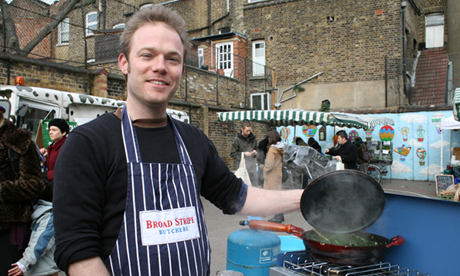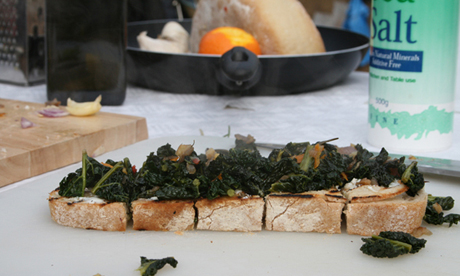Are you a kale fan?

Marketchef Tom Moggach preparing kale on toast
Marketplace: (1) A place where a public market is held. (2) Any centre where ideas, opinions, etc are exchanged.
Had any interesting chats with the staff at the supermarket lately? Looked forward to seeing what unusual goodies they might have on the shelves this week? Got any useful cooking tips from the cashier? The dictionary definition above reminds us what the traditional market, held in our local street, square or spare bit of land, has to offer.
Markets represent our oldest and most successful form of exchange, and have been carefully organised and promoted since medieval times, when the right to hold one became a highly valued privilege granted by the monarch to the nobles who enjoyed his or her favour.
A royal charter laid down when and where markets could be held, and such was their importance that towns grew up around the sites of regular marketplaces.
Traders would often make a round trip of up 20 miles on foot or by horse and cart, so market day was just that – a whole day dedicated to the event. It would usually take a third of the day to get to the chosen location, a third would be spent selling produce and the journey home would use up the final third, so, by splitting the typical 20-mile journey, it was determined that markets must be at least 6 2/3 miles apart.
This calculation is still used today as the basis for the protection of market rights, though other markets can still be held provided that they are licensed by the holder of the royal charter, which these days tends to be the local town council.
Up until the 19th century the majority of people in Britain made their living through agriculture. Most lived where they worked, and there were relatively few towns, so taking their produce to market gave farmers the opportunity to socialise, too. Though city living brings us into regular contact with thousands of people, a visit to our local market still provides a welcome opportunity to shop in what is usually a pretty convivial atmosphere.
Hackney street markets such as Ridley Road or Hoxton Street offer a varied mix of produce, all sold amidst a bustle of traders from different cultures and communities. And Broadway Market’s motto of ‘quality, speciality, variety’ highlights another benefit to shopping at farmers’ markets: traders are specialists selling the best they have to offer and are a mine of useful information on how your food was grown or reared, and what’s the best way to cook and enjoy it.
Those of us feeling the pinch ought to get ourselves to market, too. A 2006 report by the New Economics Foundation found that at Queen’s Market in east London, a typical street market, items were, on average, 53 per cent cheaper than at a local Asda. And though farmers’ markets are more expensive than street markets, they still charge 11 per cent less than supermarkets.
If you need any more encouragement, how about a little green thinking? Buying locally-produced food cuts down on food miles, reducing greenhouse gas emissions, and you won’t see all the double and triple wrappings of paper, cardboard and plastic that load supermarket shelves, either.
But the best reason to shop with your local stallholders is that your taste buds will thank you for it. Farmers’ markets sell the freshest food you can buy.
At Stoke Newington Farmers’ Market for example, all produce comes from within 100 miles of Hackney, and has often been pulled from the ground that morning.
Though we all know that it’s a good idea to eat our greens, some of our less glamorous veg sometimes get a little neglected. With this in mind, Growing Communities at Stoke Newington Farmers’ Market invites anyone to be the next Marketchef.
The idea is to get local people sharing their favourite recipes for seasonal food, and as the cooking takes place in the middle of the market, you can taste the results too. In February, Tom Moggach glammed up a member of the kale family. Here’s the recipe.

The humble kale makes a proud toast
Cavolo nero on toast
[audio:kaleontoast.mp3]Serves 4 as a snack or starter
Cavolo nero is also known as Tuscan kale or black cabbage. It’s a hardy brassica that grows through winter. This is a twist on a recipe from Sophie Grigsons ex’cellent book, Vegetables.
1 onion
3 garlic cloves
1 red chilli, deseeded
1 bunch cavolo nero (approx 250g)
Sprig of rosemary
1 orange
Sourdough bread
Soft goat’s cheese
Finely chop the onion, garlic and chilli. In a heavy-based pan that has a lid, heat some olive oil, then fry the onion over a low heat until soft and translucent.
While the onion cooks, roughly chop the cavolo nero lengthways into thin strips, discarding tough and woody stems. Wash in a colander but do not dry.
When the onion is just about done, add the garlic, chilli and rosemary (Check the heat of the chilli, as they vary wildly). Fry for another minute.
Add the cavolo nero, sprinkle on some salt, give it a stir and put on the lid. Cook on the lowest heat possible for about 20 minutes, checking once or twice to make sure it does not stick. A few minutes before serving, grate in some orange zest and season to taste. Fish out the rosemary sprig.
Toast the bread. Rub each slice with half a garlic clove and drizzle with olive oil. Spread with the goat’s cheese, top with cavolo nero and serve.
If you would like to take part in the Marketchef project, please contact Growing Communities on 020 7502 7588 or growcomm@growingcommunities.org.
